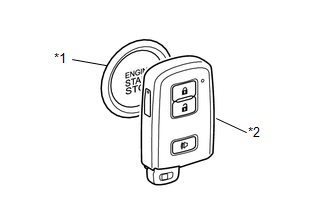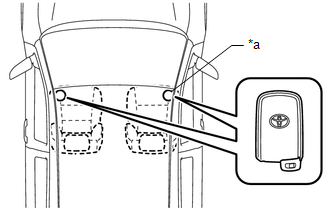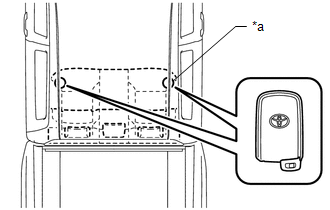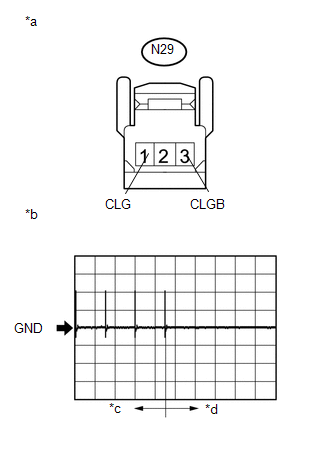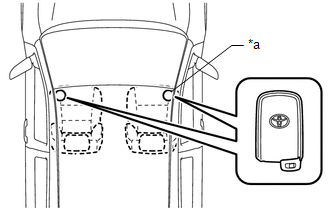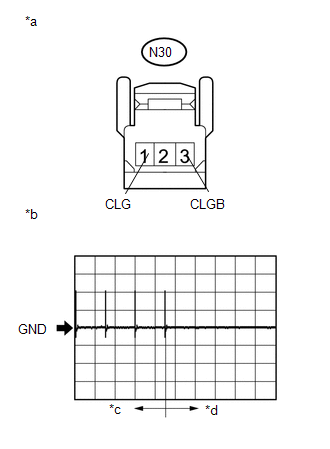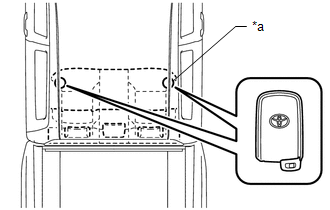Toyota Tacoma (2015-2018) Service Manual: Room Oscillator does not Recognize Key
DESCRIPTION
If code verification cannot be performed in the vehicle interior, there may be problems with the communication between the vehicle (indoor electrical key antenna assembly (front floor) or (rear floor)) and electrical key transmitter sub-assembly, or the certification ECU (smart key ECU assembly) may be malfunctioning. When the electrical key transmitter sub-assembly is brought into the vehicle, verification of the key ID code transmitted from the electrical key transmitter sub-assembly and the key ID code stored in the certification ECU (smart key ECU assembly) is performed. If verification cannot be performed or the codes do not match, the engine switch cannot be turned on (IG) and the engine cannot be started.
When a door is unlocked and the electrical key transmitter sub-assembly is brought into the vehicle, the certification ECU (smart key ECU assembly) activates the indoor electrical key antenna assembly which transmits radio waves to detect the electrical key transmitter sub-assembly. If the electrical key transmitter sub-assembly recognizes that it is in the detection area, it responds with the key ID code. This information is received by the indoor electrical key antenna and then sent to the certification ECU (smart key ECU assembly).
HINT:
- If the room oscillator does not recognize, the cause of the malfunction may be stored in the certification ECU (smart key ECU assembly).
- If the cause of the malfunction is stored in the certification ECU (smart key ECU assembly), the following table is helpful in checking whether the malfunction was caused by wave interference.
|
Parameter Name |
Cause of Problem and Countermeasure |
|---|---|
|
Operating Engine Switch / Key RF Signal Interference |
When the engine switch was operated, the electrical key transmitter sub-assembly could not be confirmed due to wave interference. Therefore, the output frequency was switched to the other channel (changed from channel 1 to channel 2 or from channel 2 to channel 1). If the cause of the malfunction has not been stored but any devices that can cause wave interference in the cabin have been removed and the room oscillator successfully recognizes the key, the possibility of wave interference is high. |
WIRING DIAGRAM
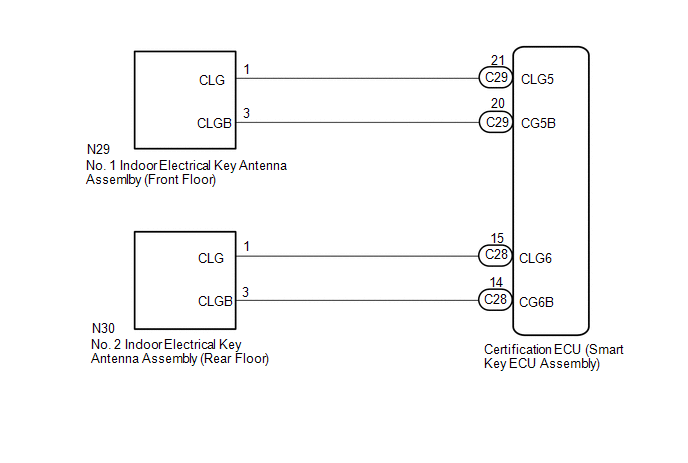
CAUTION / NOTICE / HINT
NOTICE:
- The smart key system (for Entry Function) uses the LIN communication
system and CAN communication system. Inspect the communication function
by following How to Proceed with Troubleshooting. Troubleshoot the smart
key system (for Entry Function) after confirming that the communication
systems are functioning properly (See page
.gif) ).
). - When using the Techstream with the engine switch off, connect the Techstream to the DLC3 and turn a courtesy light switch on and off at intervals of 1.5 seconds or less until communication between the Techstream and the vehicle begins. Then select the vehicle type under manual mode and enter the following menus: Body Electrical / Smart Key. While using the Techstream, periodically turn a courtesy light switch on and off at intervals of 1.5 seconds or less to maintain communication between the Techstream and the vehicle.
- Before replacing the certification ECU (smart key ECU assembly), refer
to smart key system (for Entry Function) Precaution (See page
.gif) ).
). - After repair, confirm that no DTCs are output by performing "DTC Output Confirmation Operation".
- The indoor electrical key antenna assemblies have an antenna coil between each terminal.
- The electrical key and TPMS receiver assembly is also related to interior verification.
PROCEDURE
|
1. |
CHECK START OPERATION |
(a) Using another registered electrical key transmitter sub-assembly, check that the engine starts.
Result|
Result |
Proceed to |
|---|---|
|
Engine cannot be started |
A |
|
Engine can be started |
B |
| B | .gif) |
END (ELECTRICAL KEY TRANSMITTER SUB-ASSEMBLY WAS DEFECTIVE) |
|
|
2. |
CHECK ENTRY LOCK OPERATION |
(a) Check that the entry lock and unlock functions operate on each door.
HINT:
If the electrical key and TPMS receiver assembly is defective, code verification does not begin in the cabin and the entry lock and unlock functions do not operate.
Result|
Result |
Proceed to |
|---|---|
|
All door entry functions operate normally (w/ Wireless Charging System) |
A |
|
All door entry functions operate normally (w/o Wireless Charging System) |
B |
|
All door entry functions does not operate normally |
C |
| B | .gif) |
GO TO STEP 4 |
| C | .gif) |
GO TO OTHER PROBLEM |
|
|
3. |
CHECK WIRELESS CHARGING SYSTEM |
(a) Turn the wireless charging system off (See page
.gif) ).
).
(b) Check that interior verification is normal.
HINT:
If the power source mode can be changed, interior verification is normal.
Result|
Result |
Proceed to |
|---|---|
|
Interior verification is abnormal |
A |
|
Interior verification is normal |
B |
| B | .gif) |
GO TO WIRELESS CHARGING SYSTEM |
|
|
4. |
CHECK PUSH-BUTTON START FUNCTION |
|
(a) Remove the transmitter battery of the electrical key transmitter
sub-assembly (See page |
|
(b) With the brake pedal depressed, face the logo side of the electrical key transmitter sub-assembly towards the engine switch, hold the transmitter near the engine switch and then press the engine switch.
(c) When operating the engine switch, check whether the engine starts.
HINT:
- When the electrical key transmitter sub-assembly cannot be verified even though it is inside the detection area, the engine start check can be performed by removing the transmitter battery from the electrical key transmitter sub-assembly and holding the electrical key transmitter sub-assembly near the engine switch.
- If the engine cannot be started when performing this inspection, the certification ECU (smart key ECU assembly) or steering lock ECU (steering lock actuator or UPR bracket assembly) may be malfunctioning.
OK:
Engine starts.
Text in Illustration|
*1 |
Engine Switch |
|
*2 |
Electrical Key Transmitter Subassembly |
| NG | .gif) |
GO TO SMART KEY SYSTEM (FOR START FUNCTION) |
|
|
5. |
CHECK WAVE ENVIRONMENT |
(a) Install the transmitter battery to the electrical key transmitter sub-assembly
(See page .gif) ).
).
(b) Bring the electrical key transmitter sub-assembly near the No. 1 indoor electrical
key antenna assembly (front floor) and perform a smart key system check (See page
.gif) ).
).
NOTICE:
Communication may not be possible if the electrical key transmitter sub-assembly is within 0.2 m (0.656 ft.) of the No. 1 indoor electrical key antenna assembly (front floor).
(c) Bring the electrical key transmitter sub-assembly near the No. 2 indoor electrical
key antenna assembly (rear floor) and perform a smart key system check (See page
.gif) ).
).
HINT:
Check that the customize status of the "Ignition Available Area" has been "All".
NOTICE:
Communication may not be possible if the electrical key transmitter sub-assembly is within 0.2 m (0.656 ft.) of the center of the No. 2 indoor electrical key antenna assembly (rear floor).
HINT:
- As the effect of wave interference decreases by moving the electrical key transmitter sub-assembly close to each indoor electrical key antenna assembly, it may be possible to check whether wave interference is the cause of the problem.
- If the inspection result is that the problem only occurs in certain locations or at certain times of day, the possibility of wave interference is high. Also, added vehicle components may cause wave interference. If installed, remove them and perform the operation check.
- There may be wave interference if the vehicle is near broadcasting antennas, large video displays, wireless garage door opener systems, wireless security cameras, home security systems, etc. In this case, move the vehicle to a different location and check if there is any improvement.
- If a tool for checking radio waves, such as a signal strength meter, is available, move around the area while observing both the LF band (used by the vehicle antenna to form the detection area) and RF band (used by the electrical key transmitter sub-assembly for transmission) to check for locations where there is wave interference.
OK:
The engine starts when the electrical key transmitter sub-assembly is held near each indoor electrical key antenna assembly and the engine switch is pressed.
Result|
Result |
Proceed to |
|---|---|
|
NG |
A |
|
OK |
B |
| B | .gif) |
AFFECTED BY WAVE INTERFERENCE |
|
|
6. |
CHECK FOR DTC |
(a) Check for DTCs (See page .gif) ).
).
OK:
DTCs are not output.
| NG | .gif) |
GO TO DIAGNOSTIC TROUBLE CODE CHART |
|
|
7. |
CHECK KEY DIAGNOSTIC MODE |
(a) Check the following antennas in key diagnostic mode (See page
.gif) ).
).
(b) Select either channel 1 or channel 2 and inspect key diagnostic mode for each channel.
|
(1) Check the No. 1 indoor electrical key antenna assembly (front floor). When the electrical key transmitter sub-assembly is at the inspection point, check that the wireless door lock buzzer sounds. Text in Illustration
|
|
|
(2) Check the No. 2 indoor electrical key antenna assembly (rear floor). When the electrical key transmitter sub-assembly is at the inspection point, check that the wireless door lock buzzer sounds. Text in Illustration
HINT:
|
|
| A | .gif) |
REPLACE CERTIFICATION ECU (SMART KEY ECU ASSEMBLY) |
| C | .gif) |
GO TO STEP 12 |
|
|
8. |
CHECK HARNESS AND CONNECTOR (CERTIFICATION ECU (SMART KEY ECU ASSEMBLY) - NO. 1 INDOOR ELECTRICAL KEY ANTENNA ASSEMBLY (FRONT FLOOR)) |
(a) Disconnect the C29 certification ECU (smart key ECU assembly) connector.
(b) Disconnect the N29 No. 1 indoor electrical key antenna assembly (front floor) connector.
(c) Measure the resistance according to the value(s) in the table below.
Standard Resistance:
|
Tester Connection |
Condition |
Specified Condition |
|---|---|---|
|
C29-21 (CLG5) - N29-1 (CLG) |
Always |
Below 1 Ω |
|
C29-20 (CG5B) - N29-3 (CLGB) |
Always |
Below 1 Ω |
|
C29-21 (CLG5) or N29-1 (CLG) - Body ground |
Always |
10 kΩ or higher |
|
C29-20 (CG5B) or N29-3 (CLGB) - Body ground |
Always |
10 kΩ or higher |
(d) Reconnect the C29 certification ECU (smart key ECU assembly) connector.
| NG | .gif) |
REPAIR OR REPLACE HARNESS OR CONNECTOR |
|
|
9. |
CHECK CERTIFICATION ECU (SMART KEY ECU ASSEMBLY) OUTPUT TO NO. 1 INDOOR ELECTRICAL KEY ANTENNA ASSEMBLY (FRONT FLOOR)) |
|
(a) Using an oscilloscope, check the waveform. OK:
|
|
| NG | .gif) |
REPLACE CERTIFICATION ECU (SMART KEY ECU ASSEMBLY) |
|
|
10. |
REPLACE NO. 1 INDOOR ELECTRICAL KEY ANTENNA ASSEMBLY (FRONT FLOOR) |
(a) Temporarily replace the No. 1 indoor electrical key antenna assembly (front
floor) with a new one (See page .gif) ).
).
|
|
11. |
CHECK KEY DIAGNOSTIC MODE |
(a) Check the following antenna in key diagnostic mode (See page
.gif) ).
).
(b) Select either channel 1 or channel 2 and inspect key diagnostic mode for each channel.
|
(1) Check the No. 1 indoor electrical key antenna assembly (front floor). When the electrical key transmitter sub-assembly is at either inspection point, check that the wireless buzzer sounds. HINT:
OK: Wireless buzzer sounds. Text in Illustration
|
|
| OK | .gif) |
END (NO. 1 INDOOR ELECTRICAL KEY ANTENNA ASSEMBLY (FRONT FLOOR) WAS DEFECTIVE) |
| NG | .gif) |
REPLACE CERTIFICATION ECU (SMART KEY ECU ASSEMBLY) |
|
12. |
CHECK HARNESS AND CONNECTOR (CERTIFICATION ECU (SMART KEY ECU ASSEMBLY) - NO. 2 INDOOR ELECTRICAL KEY ANTENNA ASSEMBLY (REARFLOOR)) |
(a) Disconnect the C28 certification ECU (smart key ECU assembly) connector.
(b) Disconnect the N30 No. 2 indoor electrical key antenna assembly (rear floor) connector.
(c) Measure the resistance according to the value(s) in the table below.
Standard Resistance:
|
Tester Connection |
Condition |
Specified Condition |
|---|---|---|
|
C28-15 (CLG6) - N30-1 (CLG) |
Always |
Below 1 Ω |
|
C28-14 (CG6B) - N30-3 (CLGB) |
Always |
Below 1 Ω |
|
C28-15 (CLG6) or N30-1 (CLG) - Body ground |
Always |
10 kΩ or higher |
|
C28-14 (CG6B) or N30-3 (CLGB) - Body ground |
Always |
10 kΩ or higher |
(d) Reconnect the C28 certification ECU (smart key ECU assembly) connector.
| NG | .gif) |
REPAIR OR REPLACE HARNESS OR CONNECTOR |
|
|
13. |
CHECK CERTIFICATION ECU (SMART KEY ECU ASSEMBLY) (OUTPUT TO NO. 2 INDOOR ELECTRICAL KEY ANTENNA ASSEMBLY (REAR FLOOR)) |
|
(a) Using an oscilloscope, check the waveform. OK:
|
|
| NG | .gif) |
REPLACE CERTIFICATION ECU (SMART KEY ECU ASSEMBLY) |
|
|
14. |
REPLACE NO. 2 INDOOR ELECTRICAL KEY ANTENNA ASSEMBLY (REAR FLOOR) |
(a) Temporarily replace the No. 2 indoor electrical key antenna assembly (rear
floor) with a new one (See page .gif) ).
).
|
|
15. |
CHECK KEY DIAGNOSTIC MODE |
(a) Check the following antenna in key diagnostic mode (See page
.gif) ).
).
(b) Select either channel 1 or channel 2 and inspect the diagnostic mode for each channel.
|
(1) Check the No. 2 indoor electrical key antenna assembly (rear floor). When the electrical key transmitter sub-assembly is at the inspection point, check that the wireless door lock buzzer sounds. HINT:
OK: Wireless buzzer sounds. Text in Illustration
|
|
| OK | .gif) |
END (NO. 2 INDOOR ELECTRICAL KEY ANTENNA ASSEMBLY (REAR FLOOR) WAS DEFECTIVE) |
| NG | .gif) |
REPLACE CERTIFICATION ECU (SMART KEY ECU ASSEMBLY) |
 Entry Interior Alarm does not Sound
Entry Interior Alarm does not Sound
DESCRIPTION
The smart key system (for Entry Function) uses the buzzer in the combination
meter assembly to perform various vehicle interior warnings. When the conditions
of each warning are met, ...
 Additional Key cannot be Registered
Additional Key cannot be Registered
DESCRIPTION
If additional registration is not possible, a malfunction in the certification
ECU (smart key ECU assembly), engine switch, electrical key transmitter sub-assembly
or steering lock EC ...
Other materials:
Noise Filter(for 2gr-fks)
Components
COMPONENTS
ILLUSTRATION
Removal
REMOVAL
PROCEDURE
1. DISCONNECT CABLE FROM NEGATIVE BATTERY TERMINAL
2. REMOVE V-BANK COVER
(See page )
3. REMOVE AIR CLEANER ASSEMBLY
(See page )
4. REMOVE RADIO SETTING CONDENSER
(a) Disconnect the connector.
(b) Remove the tape an ...
Open in ABS Solenoid Relay Circuit (C146E,C146F)
DESCRIPTION
The ABS solenoid relay supplies power to the ABS solenoid and TRAC solenoid.
The solenoid relay is turned on 1.5 seconds after the ignition switch is turned
ON, and is turned off if an open or short in the solenoid is detected by the self
diagnosis performed when the engine starts ...
Automatic Disconnecting Differential Motor Limit Switch Circuit (P17A4)
DESCRIPTION
When the A.D.D. actuator switches between 2WD and 4WD, the DL1 and DL2 terminals
of the limit switch and ADD terminal of the A.D.D. position switch change to one
of the following ON/OFF combinations listed in the table below.
Terminal
In 2WD
Switchi ...

.gif)
